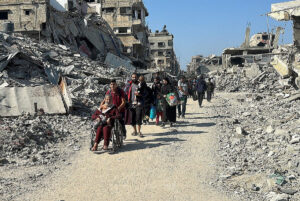In besieged Beit Lahiya, rubble and decomposing corpses line the streets

Palestinian flee the city of Beit Lahiya in northern Gaza amid Israeli bombardment, 5 November 2024
Ibrahim Mohammad reports in +972 on 18 November 2024:
“Wherever you go, you find corpses on the ground. Some are almost decomposed, while others have been run over by Israeli armored vehicles. We’re surrounded from all directions, and people don’t know where to go.”
This is the current scene in Beit Lahiya, a city at the northern tip of the Gaza Strip that has been under sustained Israeli siege and bombardment since early October, as described by 43-year-old resident Ali Hamouda.
“The city has been subjected to massive destruction of buildings and infrastructure, in an attempt to force the remaining residents to leave,” Hamouda continued. “There is no food or water, and we currently face a real famine. It’s a genocide against the residents and the displaced people who are sheltering here.”
The Israeli army launched an intense aerial and ground assault on the northernmost areas of the Gaza Strip in the early hours of Oct. 6, in an effort to empty the region of Palestinians. Much of the force of the operation was initially targeted at Jabalia refugee camp, but after forcibly displacing residents and destroying most of the camp, the military has increasingly focused its attention on Beit Lahiya.
Several hundred Palestinians have been killed as a result of Israel’s recent attacks on the city — including at least 50 in an airstrike on a multi-storey residential building on Nov. 17, and 93 in another strike on an apartment block on Oct. 29. Roughly one-third of the victims of both strikes were children.
Gaza’s civil defense rescue workers, who are barely able to operate in the north’s besieged zone, have declared Beit Lahiya a “disaster area.” The city’s two hospitals, Kamal Adwan and the Indonesian Hospital, have repeatedly come under attack. And due to the high number of casualties, residents have converted part of what was once the bustling market area into a cemetery.
The UN estimates that between 65,000 and 75,000 Gazans remain in the besieged cities of Beit Lahiya, Beit Hanoun, and Jabalia. Mahmoud Basal, a civil defense spokesperson, put that number slightly higher: closer to 80,000.
“The situation in northern Gaza, specifically in Beit Lahiya, is extremely catastrophic,” Basal stressed, adding that Israel is dropping large missiles on residential buildings “without prior warning and with
